Creature comforts: Food puzzles for a Fear Free veterinary visit
Sit. Stay. Play! Food puzzles are a practical practice tool to help create a comfortable, Fear Free veterinary visits.
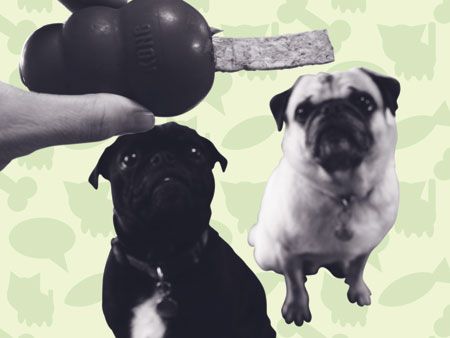
All images courtesy of Mikkel BeckerFood, glorious food! Toys and food puzzles are an excellent addition to your exam room, treatment area, hospital wards and kennels to help pets create positive associations with your practice and the veterinary visit. These tools offer healthy, happy distractions to occupy pets while you provide care. Or, if you're conditioning a pet to feel more comfortable with a more intentional approach, the rewards can be licks of treats from the toy or an opportunity to play. Food puzzles also help reduce signs of stress and sickness in cats and improve the well-being of the pet during care-and at home, too, if the owner's game.
Here's a look at different types of food puzzles and when you might use them:
1. When you want the pet to hold still
Choose puzzles you can wash and disinfect easily in between patients. These include Kongs or other stuffable toys you can fill with soft food or harder treats. The soft-fill cavity toys are ideal when you're offering veterinary care, because they're easier to use in a stationary position. This helps keep cats and dogs in place as they lick out the inner contents and you offer the needed care.
2. When you're looking for a happy distraction
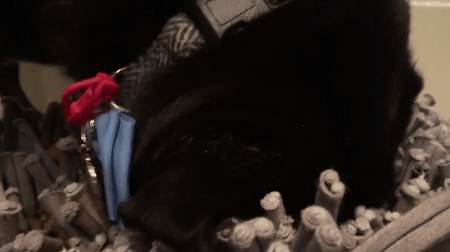
Opt for movable puzzles designed for dry food or treats for independent play and when you want the pet to move and focus on a task. For example, a moveable food puzzle may create a happy distraction when the pet's waiting for care. Some pets will enjoy searching for hidden treats beneath movable puzzle pieces or seeking scattered treats inside of a washable food mat toy (Wooly by Paw5, for example).
3. When you want to keep the pet focused or occupied
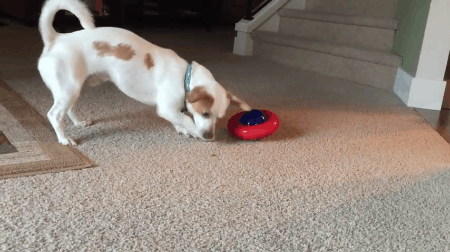
Puzzles can keep pets in kennels or cages happily occupied and focused on a task. Many pets can be transitioned to using these puzzles for meals instead of eating from a bowl. This can ease tension in multicat homes and offer mental enrichment and physical exercise.
An important note: If ingesting the toy is a concern, there are special puzzles for dogs, including blue Kongs specifically for veterinary hospitals, designed to show up on radiographs.
Keep them clean
Discard toys that are fraying or breaking apart. And if dogs with mighty jaws will be left alone with the chew activity, choose stronger puzzles designed for tough chewers.
Use them for meals
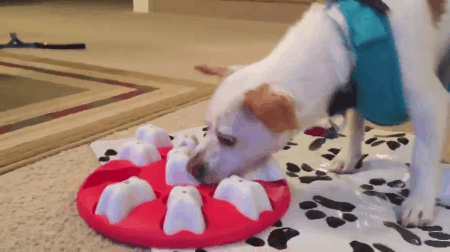
Depending on the cat or dog's experience and motivation, you can use the puzzles to enclose special treats or soft food or to house the pet's meal. These transitions can decrease the pet's tension and increase positive indicators in the home.
The levels of food puzzles vary from beginner to genius level. How you pack the treats also influences how easily the pet can solve the puzzle and consume the treat. For pets just getting used to a puzzle, pack food loosely so kibble falls easily. Then, as the pet practices and learns how to unearth the food contents, increase the difficulty by packing more densely and freezing or using a more advanced puzzle.
The benefits of food puzzles for dogs
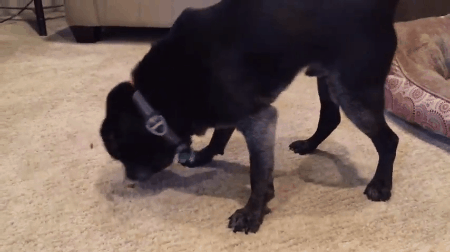
Food puzzles are an easy way to reduce excess energy and offer a calming activity for dogs. Many times, when pet owners switch a dog to eating from a food puzzle, they report their dogs are much more amicable to live with and noticeably fulfilled from using their physical and mental energy to uncover their meals.
The benefits of food puzzles for cats
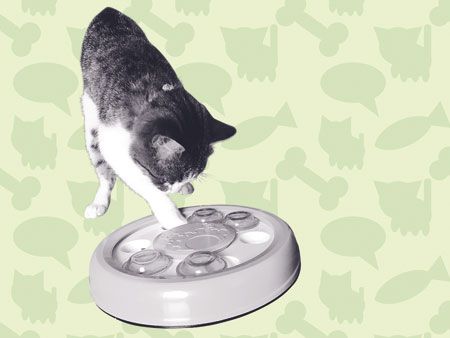
Jonesy has settled down dramatically in her new home in large part from the help of channeling her energy into food puzzles. Just this little change and things in her new house are going much better, including improved relations with her canine housemates and acting calmer around the children in the house. Switching to food puzzles from the food bowl has made a major difference with little extra effort required for this busy family.
"Paws" to consider the products
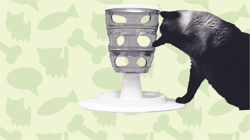
Check out feline (and human!) perspectives on some of the food puzzles designed to stimulate cats' natural hunting abilities and help get the weight off hefty cats. Our cat-on-the-scene, Maeby, highlights the top features here.
Food puzzles can help decrease anxiety-related problems in the home and settle many behavioral issues. Liz Bales, VMD, is a champion of the food bowl, specifically her specially designed NoBowl that offers cats an indoor predatory experience at mealtime. The NoBowl system is made to start at an easy level and gradually increase in difficulty as the kitty improves-working up to the cat batting and nosing multiple mini-mice-shaped food dispensers to work out the inner food contents.
You can also give other food puzzles, such as the Twist 'n Treat Teaser Toy (PetSafe), with the top off as a modified bowl. And you can screw on the top portion of the puzzle once the cat's accustomed to eating from the bottom portion of the puzzle. You can twist it loosely to make the eating experience easy and tighten to increase difficulty and healthy challenge at mealtime.
Put food puzzles to work in your practice
For the hospital setting, find puzzles that are easily washable in between uses. A bottle brush and dish detergent are all that's needed to clean most cavity food puzzles. (Get the client handout on cleaning food puzzles here.) For other food puzzles, make sure the pieces are easily moved or disconnected for thorough cleaning between uses.

Encourage pet owners to use food puzzles at home and to consider bringing them to regular veterinary appointments. A Kitty Kong can occupy a cat in the carrier on the way to the vet. Or a movable food puzzle can channel a dog's energy and focus to distract from upsetting noises and sights.
North Idaho Animal Hospital (where my father, Dr. Marty Becker, works and where I've been an animal trainer) uses food puzzles regularly during veterinary care. The hospital sells the devices to pet owners to take home from the visit. This way we care for the pet's behavioral and emotional needs both during the visit and at home to create happy distractions and positive associations in future Fear Free visits.
Mikkel Becker, CBCC-KA, CPDT-KA, CDBC, CTC, KPA Graduate, BA Communications, is the resident trainer for vetstreet.com and works in conjunction with veterinarians and veterinary behaviorists to address behavior issues in dogs and cats. Her four-legged best friend is Willy the pug, a certified therapy dog through the Delta Society.